Telangana SCERT 10th Class Social Study Material Pdf Telangana 8th Lesson Rampur: A Village Economy Textbook Questions and Answers.
TS 10th Class Social 8th Lesson Questions and Answers – Rampur: A Village Economy
Question 1.
Every village in India is surveyed once in ten years during the Census and the details are presented in the following format. Fill up the following based on information on Rampur.
a. Location:
b. Total area of the village:
c. Land Use (in hectares):
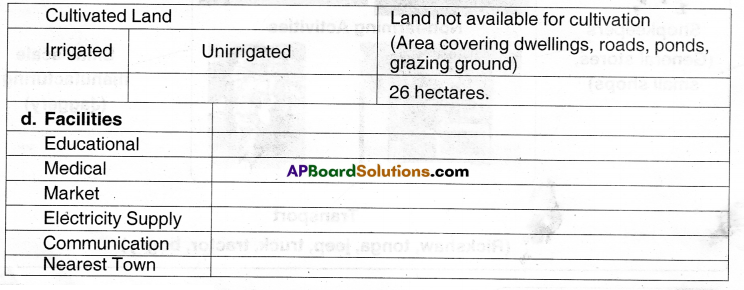
Answer:
a. Location: Ranur lies in the fertile alluvial plains of the Gangelic basin in the western part of Uttar Pradesh.
b. Total area of the village: 226 hectares
c. Land Use (lnhectares): –
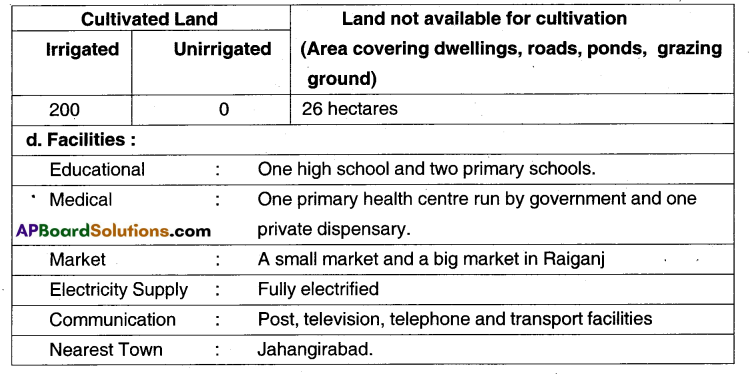
Question 2.
Why are the wages for farm labourers in Rampur less than minimum wages?
Answer:
Farm labourers n the Rarnpur village come from landless families cultivating small plots of land. The minimum wage fixed by the government for a farm labourer is Rs. 60 per day but they paid only Rs. 35, Rs. 40 a day. This is because of the fact that there is great competition for work among the farm labourers of Rampur. So they themselves agree to work at much lower wages than what was fixed by the government.
Question 3.
Talk to two labourers from your region. Choose either farm labourers or labourers working at construction states. What wages do they get ? Are they paid in cash or kind? Do they get work regularly? Are they In debt?
Answer;
I met Smt. Parvathi and Smf. Rani in our region. They both are farm labourers. They get Rs. 120 daily. They are paid in cash. They got continuous work for lO months in a year. Yes, they are in debt.
![]()
Question 4.
What are the different ways of increasing production on the same piece of land? Use examples to explain.
Answer:
The two most common ways of increasing the production are either by multiple cropping or by adopting modem farming method.
Example: Many farmers of Raropur village have adopted the process of multiple cropping to increase their production from same piece of land. During the rainy season, they grow jowar, bajra. etc. which are used for cattle feeding. Between October and December, they cultivate potatoes. In winter season they grow wheat which is partly kept for family consumption and the surplus for selling.
Question 5.
How do the medium and large farmers obtain capital for farming? How is it different from the small farmers?
Answer:
It is a fact that the small farmers with less than 2 hectares 01 land have to face much more problems than the medium or large farmers. As compared to small farmers, medium and large farmers can quite easily obtain capital for farming. The reasons are several.
Large farmers have their own savings from farming which they had accumulated year after year. So they don’t stand any need for taking loan from anywhere.
Generally, medium farmers also have their own savings to spend for the improvement of their farms. But even if they need to borrow, the amount would be small. Such farmers can go to bank directly and won’t face any difficulty In getting a loan from the bank which will be at a reasonable Interest too. The Banks feel happy to advance a loan to such farmers as they dont see any risk because of the sound economic conditions of medium or large tanners.
Question 6.
On what tennis did Savita get a loan from Tejpal? Would Savlta’s condition be different if she could get a loan from the bank at a low rate of interest?
Answer:
Being a small farmer Savitha has to face a number of problems if she wants to cultivate wheat on her 1 hectare of land. To purchase seeds, fertilizers, and pesticides for cultivating she has no money. It will be highly difficult to gel a loan from a bank. So. she approached Teipal, a large farmer of her village to getting a loan.
He agreed to give her a loan but a hefty rate of interest of 20% for four months plus on a condition of her giving a manual labour to his field. Still, Savita agrees to these terms as she knew getting a loan for a small farmer is quite a difficult task.
Savita’s condition would have been certainly better If she could get a loan from a bank at a low or reasonable rate of interest. in that event she would have also been able to bring up her three children in a better way since she would have more time for her family.
![]()
Question 7.
Talk to some elderly persons In your region and write a small report on the changes in Wrigatlon and changes in production methods during the last 30 years.
Answer:
I met Sri P. Moliana Rao of KarIrrwagar District and Sri I( Krishna Rao of Nizamabad
District to conduct the survey.
Changes in Irrigation: They reported that cultivation had gone through major changes during the last 30 years. Traditional agricultural Practices are steadily being replaced by modem farming practices. Indian agriculture has witnessed mechanization on a Large scale. The use of HYV seeds increased. The farmers have begun to set up their own pumps sets for irrigation. Unlike past, farmers now grow at least two main crops during the year. Non-farm activities are increased.
Changes in Production Method:
Sugarcane crushing was earlier done with the he4p of bullocks. but now people prefer
to do it by sugarcane crushing machine run on electricity. Human resources are mostly replaced by machines.
Question 8.
What are the main non-farm production activities taking place In your region? Write a brief report on any one such activity.
Answer:
There are many forms of non-farm production activities in our region. Some of them are
- Dairy farming
- Shop-keeping
- Brick making
- Readymade garments, etc.
Question 9.
Imagine a situation where labour is the scarce factor of production instead of land. Would the story of Rampur be different? How? Discuss in class.
Answer:
If the labour is scarce instead of land, the story of Rampur would be different. The demand for labour increases. Then their wages also increase.
Question 10.
Gosaipur and Majauli are two villages in North Bihar. Out of a total of 850 households In the two villages, there are more than 250 men who are employed In rural Punjab and Haryana or in Delhi, Mumbai, Surat, Hyderabad or Nagpur. Such migration is common in most villages across India. Why do people migrate? Can you describe (based on your imagination and previous chapter) the work that the migrants of Gosaipur and Majauli might do at the place of destination?
Answer:
Some people of Gosaipur and Majauli have migrated to the rural areas of Punjab, Haryana, Murrtal, and Nagpur. etc. The migrants are employed by the large farmers of these regions aimer as regular workers or as daily wage workers.
Question 11.
Land is also required for production of goods In an urban area. In what ways Is the use of land different from a rural area?
Answer:
In urban areas land is used for constructions, laying roads, bus terminals, and hospitals. educational institutions, parks, theatres, etc. Some of these are not present in rural areas.
Question 12.
Read again the meaning of “land” In the production process. Give three examples, other than agriculture, where this requirement Is most significant in the process of production.
Answer:
- For Dairy farm
- For sugarcane crushing and
- For transportation
Question 13.
Water, a natural resource for production, particularly agricultural production, now requires greater capital for its use. What is your opinion on li?
Answer:
- Agriculture is a major user of water resources and the consumption of water is increasing day by day.
- Indian agriculture mainly depends on rains which are Unpredictable.
- As a result the agriculture has to depend on irrigation facilities such as dams, anicuts, check dams, bunds, pools, etc., which are most expensive to construct.
- On the other hand, the farmers are depending on groundwater resources. Lifting the groundwater to surface Is also very expensive. So I can say that water, a natural resource for production, particularly agricultural production now requires greater capital for its use.
TS 10th Class Social 8th Lesson Rampur: A Village Economy Intext Questions
Page No. 103
Question 1.
a) What do you know about agriculture?
b) How do crops change in various seasons?
c) Do most people depending on agriculture belong to land-owning groups or labourers?
Answer:
a)
- Agriculture Is the simplification of nature5 food webs and the rechanneling of energy for human parenting and animal consumption.
- Agriculture is the primary source of employment for us and it comes under primary sector.
- It needs immigration facilities.
b) A seed needs water, sunlight, and the soil to grow. Some plants grow n certain conditions. So. the Grc.tS change various seasons.
c) Most people depending on agriculture belong to labourers.
![]()
Question 2.
Looking at an atlas, identify the areas that are well irrigated. Does your region tall under this category?
Answer:
- Well irrigata aoas n India are Punjab. Haryana and Uttar Pradesh.
- Moderate to high irrigated areas are Bihar, Tamil Nadu, Jammu & Kashmir, Manipur. Telangana ends Andhra Pradesh.
- In our state, most of the region is tank irrigated.
- Quite a considerable region is under canal irrigation.
- Our region falls under this category.
3. The following table shows the land under cultivation In India in units of million hectares. Plot this on the graph provided. What does the graph show? Discuss in class.

Answer:
- The graph shows that the cultivated area from 1970 to 2010 remained the same.
- New area was not brought under cultivation.
- Even some area was brought, the same amount of area from cultivated land was used as non-farm area.
- The area of the country is not extending.
- The demand for non-farm land is also increasing.
- So there was no growth recorded in cultivated area for the last 40 years or so.

Question 4.
You have read about the crops grown in Rampur. Fill the following table based on information on the crops grown in your region.

Answer:

Question 5.
What are the reasons for multiple cropping In cultivation?
Answer:
- The cultivation which is under multiple cropping has many reasons for ¡t.
- it has a well-developed irrigation system.
- Different crops are grown in three crop seasons.
- It increases the production from land.
- They may have two main crops and a third crop.
- There Is no land that is left idle.
- There is no possibility of expansion in land area under cultivation.
- The plants grown are also used as cattle feed.
Page No.107
Question 6.
In the map given below, shade the small plots of land.

Answer:
Self Activity.
Question 7.
Why do so many families of farmers cultivate such small plots of land? k1.rT
Answer:
- Not a the people engaged in agriculture have sufficient land for cultivation.
- The upper caste families own majority of the land in the village.
- They have land extending over 10 hectares or more.
- Many families cultivate small plots of land less than 2 hectares.
- Cultivation of such plots doesn’t bring adequate income to the fam,etc family.
- Even these small plots were divided among sons when their father was dead.
- Thus so many families ut farmers cultivate such small plots.
Question 8.
The distribution of farmers in India and the amount of land they cultivate are given in the following table and pie charts.

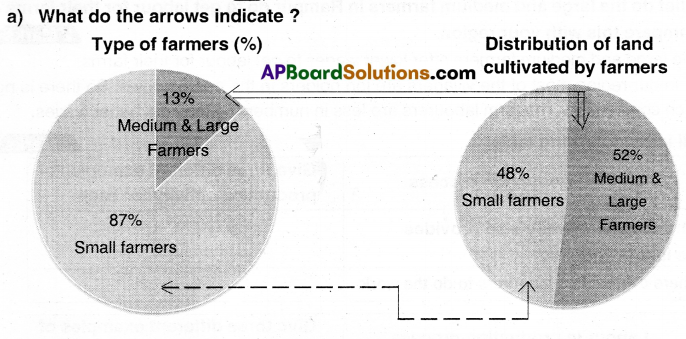
Answer:
1) The arrows indicate that 87% of the total farmers are cultivating only 48% of the total cultivated land.
2) The remaining 13% of the farmers are cultivating the remaining 52% of the land.
3) This Indicates that there is no equal distribution of land among farmers.
4) I would agree that the distribution of cultivated land‘s unequal in India.
![]()
b) Would you agree that the distribution of cultivated land is unequal In India? Explain.
Answer:
Yes, I agree that the distribution of cultivated land is unequal in India. In Rampur, 240 families cultivate small plots of land less than 2 hectares in size whereas remaining cultivate more than 2 hectares of land. A few of the large farmers have land extending over lOor more hectares. We find the similar situation in India also.
Page No. 108
Question 9.
Small farmer, Big farmer. After reading next section (Land for the Farm) write a caption that would describe their relation with the factors of production.

Answer:
Small farmer should carry the field while the field Carnes big farmers.
Page No. 109
Question 10.
Why are farm labourers like Shivaiah poor? frlrThfl
Answer:
Shivaiah is a landless farm labourer who works on daily wages. He must regularly look for work. The daily wages for a farm labourer was set up by the government as Rs. 60 per day, but Shlvaiah gets only Rs. 35- Rs. 40. There is a tough competition for work among the labourers. So people agree to work for lower wages. So the farm labourers like Shivaiah are poor. Snail farmers
Question 11.
What do the large and medium farmers In Rampur do to get labour for their farms? Compare this with your region.
Answer:
The large and medium farmers offer lower wages to get labour for their farms. In our region most of the villagers are job holders In the nearest town. So there is no such competition. The farm labourers are less in quarter. So they get better wages.
Question 12.
Fill in the following table:
| Labour In production process | Give three different examples of production activity for each |
| Where owner/family also provides the labour required | |
| Where owners hire labourers to do the work |
Answer:
| Labour in production process | Give three different examples of production activity for each |
| Where owners/ family also provides | Cottage industries, Small-scale industries |
| Where owners hire labourers to do the work | Large scale industries |
Question 13.
What are the ways for providing labour, in the production of goods or services that you observe in your region?
Answer:
In our region, these are the ways of providing labour in the production of goods or services.
- Self
- Direct employment
- Through employment agencies. etc.
Page No. 110
Question 14.
Read the following table.

a) Compare the figures for daily wages given above with those prevailing in your region for any of the operations.
Answer:
The daily wages In our report are also same as above. The minimum wage for men Is Rs. 200/- and for women is Rs. 150/-. In the ven data, there are many variations.
b) Find out the minimum wage and compare It with this.
Answer:
Minimum daily wage = Rs. 125 per day for both male and female. We can say that the labour in our area are getting favorable figures.
c) Why do you think do men receive a higher wage than women for the same job? Discuss.
Answer:
I think this practice is mostly in the agricultural sector and industrial sectors. In these two sectors, the quantity of work depends on the physical strength of the labourer. Men are physically strong than women. So they are paid more wages.
Page No. 112
Question 15.
a) Surplus and Capital for Production.
Consider three farmers. Each has grown wheat on his field though the production is different as in Column 2. To analyse the situation faced by different farmers, we need to assume that some conditions ai. the same for all. To keep things simple, let us suppose the following conditions:
1) The consumption of wheat by each farmer tan’Wly is the same (Cokmin 3).
2) The whole of surplus wheat this year is used as seeds for working capital for the next year’s production by all the farmers. They also have land to do so.
3) Also spouse, production output is twice the working capital used in production in all the farms. There is no sudden loss n production.
Complete the table.
Farmer 1 :
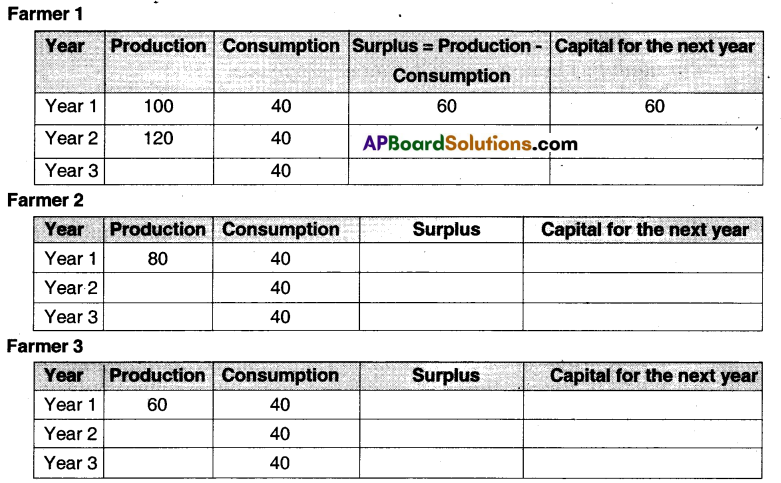
Answer:

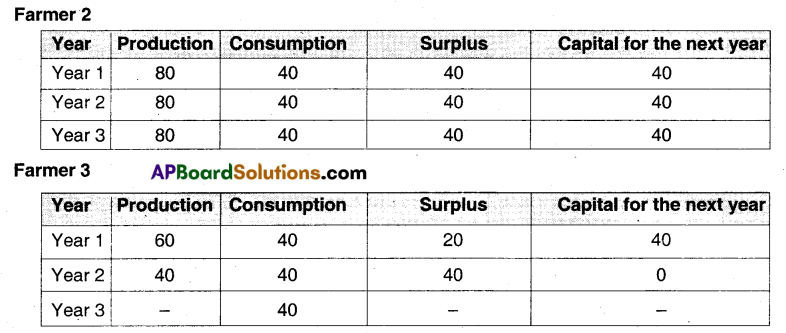
b) Compare the production of wheat by the three farmers over the years.
Answer:
The production of Farmer- 1 goes on Increasing.
The production of Farrner – 2 remains the same.
The production of Farmer-3 goes on decreasing year by year.
![]()
c) What happens to the Farmer 3 in Year 3? Can h. continue production? What will he have to do to continue production?
Answer:
Farmer 3 has no savings in the second year. So he has no capital to an production. He will have to approach the moneylender for loan to start production.
Page No.113& 114
Read the following paragraph and answer the questions.
Mishrdal has purchased a mechanical sugarcane crushing machine runs on electricity and prepares jaggery. Earlier, sugarcane was crushed by using bullocks, but these days people prefer to do It with machines. Apart from using the sugarcane that Mishrilal has cultivated, he also buys sugarcane from other farmers and processes it into jaggery. The jaggery Is then sold to traders at Jahangirabad. In the process, Mishrilal makes a
small profit.
Question 18.
What physical capital did Mlshrllal need to set up this process?
Answer:
- Mishrilal set up the process where in he can prepare angry.
- Earlier sugarcane was crushed by using bullocks.
- But these days people prefer to do Ii by machines.
- Mishnlal has purchased a mechanical sugarcane crushing machine run on electricity.
- That s the physical capital he needed to set up this process.
Question 17.
Who provides the labour in this case?
Answer:
- The labour in this case is provided by Mishnlal himself.
- At times, he may be supported by has family members.
Question 18.
Why Is MishrIlal unable to Increase his profit? Think of the situation when he could face a loss.
Answer:
- Mishrilal prepares jaggery from sugarcane with a machine.
- He sells it to traders at Jahangèrabad.
- He uses the sugarcane he has cultivated and also buys sugarcane from others.
- Thus he is making a small profit.
- His production is Ni small scale, he also buys from others, the sugarcane and there is a mechanism to provide him with a minimum support price.
- He sells to traders at Jahangirabad which results in transportation expenses.
- So he es unable to increase lUs profit.
- He could face loss when the prices of jaggery in the marked are decreased sharply.
Question 19.
Why does MishrlIal sell jaggery to traders In Jahanglrabad and not In his village?
Answer:
- Mishnlal sells jaggery to traders in Jahangirabad.
- He cannot sell all the angry he has made in Rampur itself.
- So he would sell it to the traders of Jahangerabad.
Page No. 114
Read the following paragraph and answer the questions.
A few fanihes whose houses are dose to the bus stand have used a part of the space to open small shops. They sell eatables like tea, and samosa. kachori, namkeen, sweats. Coffees, cold drink. etc. The women and the children In the family share the work together.
In our country. a large section of people are self-employed like farmers, shopkeepers, hawkers, etc. They are owners because they have lo plan and organize and take the risk of producing goods or services. At the same time, they also provide their own labour to manage the process.
![]()
Question 20.
On whose land is the shop located?
Answer:
The shop is located on the house of the family whose house is located near the bus stand.
Question 21.
Who supplies labour to these small shops selling eatables?
Answer:
They are self-dependents, They use their family members.
Question 22.
Guess what working capital would such shops require.
Answer:
Fixed capital.
Question 23.
List the physical capital items.
Answer:
Alrmrahs with mirrors, shop, desk, weights and measures like balance, stones, boxes for
packing, etc.
Question 24.
From a hawker in your area, find out about his daily sales. How will you find out If there Is some savings? Discuss with your teacher.
Answer:
I interviewed a hawker Mrs. Laxzm in our area. She sells sweets. She gets a profit at’ Rs. 200 to Rs. 300 daily. She saves through ‘Dwacra’ in the nearest bank.
Page No. 115
Read the following paragraph and answer the questions.
Kishore is a Farm Labourer. Like other labourers, Kishore found it difficult to meet his family’s needs from the wages that he received. A few years back, Kishore took a loan from the bank. This was under a government program which was giving cheap loans to poor landless households. Kishore bought a buffalo with this money. He now sells the buffalo milk.
Further, he has attached a wooden cart to his buffalo and uses it to transport various Items. Once a week, he goes to the Ganges to bring back clay for the potter. Or sometimes he goes to Jahangirabad with a load of jaggary or other commodities. Every month, he gets some work in the transport services. As a result, Kishore is able to earn more than what he used to some years back.
Question 25.
What Is Kishore’s fixed capital?
Answer:
Kishore’s fixed capital includes a buffalo, and a wooden cart.
Question 26.
What do you think would be his working capital?
Answer:
Kishore has a loan from the bank which could be his working capital.
Question 27.
In how many production activities is Kishome involved?
Answer:
Kishore is involved in the following activities
- He works as a farm labourer.
- Dairying is his another activity.
- 1-le is also involved in transport activity.
![]()
Question 28.
Would you say that Kishore has been benefited from better roads In Rampur?
Answer:
- Kishore has definitely benefited from the better roads in Rampur.
- Because of them, he is able to transport various items and people
- He is able to earn more than what he used to do some years back.